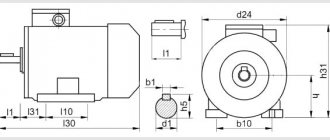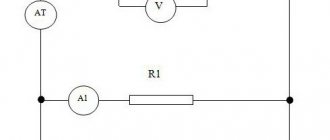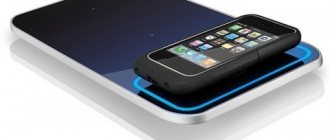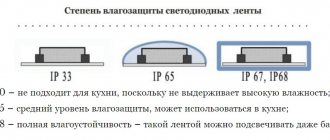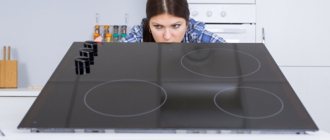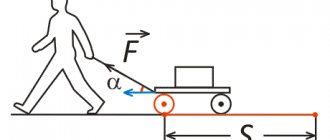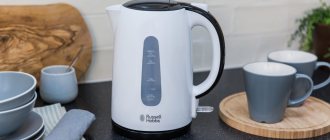When you receive a receipt for electricity, you sometimes wonder where this amount came from and why the meter counted so much. To make sure that the equipment and electricity meter are working properly, you need to determine the electricity consumption using available methods. To do this, we assume that we have a multimeter, an electricity meter or a current clamp in our arsenal. So, below we will tell you how to determine the power consumption of a device at home!
What is power consumption?
Power consumption is a numerical measure of the amount of electrical energy required for the operation of an electrical appliance or converted by it during operation. For static devices (stove, iron, TV, lighting), current energy turns into heat during operation). During conversion (electric motors), the energy of electric current is converted into mechanical energy.
The basic unit of electrical power is Watt, its numerical value
P = U × I,
where U is voltage, Volts, I is current, amperes.
Sometimes this parameter is indicated in V×A (V×A for imported equipment), which is more correct for alternating current. The difference between Watts and VA for household networks is small and can be ignored.
Electrical power consumption is important when planning wiring (the cross-section of the wires depends on it, as well as the choice of ratings and the number of circuit breakers). During operation, it determines the costs of maintaining the home.
Definition
Let's start with the definition of power : this is the work done per unit of time. And it doesn’t matter what kind of work we are talking about, electrical or mechanical. This physical quantity is an indicator of operating efficiency, as well as the amount of energy consumed by an electrical appliance.
Utility bills include the cost of electricity consumption. The following household appliances consume it:
The number of these devices is much larger. And each of them contributes to the amount for your utilities.
For example, the power consumption of your vacuum cleaner is 1 thousand watts per hour . Accordingly, if you vacuum for 30 minutes, it consumes 500 watts. One thousand watts per hour equals one kilowatt per hour. This is a common unit for calculating energy consumption in utilities.
For example, during this month you vacuumed your apartment 6 times for half an hour. Accordingly, the vacuum cleaner worked for 3 hours and consumed 3 kilowatts per hour from the electrical network. The cost of one kilowatt per hour is 3 rubles. This means that you need to pay 9 rubles for the energy that your vacuum cleaner consumed while cleaning the apartment. Using the same principle, your expenses with other electrical appliances are calculated.
Read also: Vertical drilling machine 2n135 passport
It is necessary to calculate power for the following purposes:
- Optimization of costs for consumed electricity.
- Ensuring your safety.
- Evaluating the effectiveness of your work.
Of course, all these calculations are made for different types of this physical quantity. There are two of them:
Let's talk in more detail about each of them.
The problem of proper operation of the household electrical network
From a constructive point of view, the household electrical network has been developed to a high degree of perfection: its normal operation does not require special knowledge.
The network is designed for certain operating conditions, the violation of which leads to complete or partial failure, and in severe cases, to a fire.
The condition for proper operation is the absence of overload.
At the same time, the load capacity of sockets and the consumption of equipment connected to them are measured in different units:
- for sockets this is the maximum permissible alternating current (6 A for traditional Soviet sockets of old housing stock, 10 or even 16 A for European-style sockets);
- connected equipment is characterized by power, which is measured in Watts (for powerful devices, larger units are indicated instead of Watts: kilowatts (1 kW = 1000 W), which allows you to avoid confusion with numerous zeros).
Hence the need arises:
- determining the relationship between power and current;
- finding the power of an individual electrical appliance.
The relationship between Watts and Amps is simple and follows directly from the definition of Watt above. The task is simplified by the fact that the voltage of a working household network is always the same (220 or 230 V). From here, power is always found along the current.
How much does an electric boiler consume?
Electric boilers are installed in houses for heating and water heating. However, the simplicity of the design and ease of operation hides high energy consumption. Models of electric boilers differ in power, design, number of circuits and method of heating the coolant (heating elements, electrode or induction heating). Double-circuit boilers are used for heating and water heating. Boiler models are more economical than flow-through ones.
The choice of boiler is made on the basis of the required power that it must have to ensure heating of premises of a given area. When calculating, it should be taken into account that kW is the minimum power of the device required to heat 10 sq.m. of room area. Additionally, climatic conditions, the presence of additional insulation, the condition of doors, windows, floors and the presence of cracks in them, and the thermal conductivity of walls are taken into account.
Note! The final power of an electric boiler is influenced by the method of heating the coolant, while electrode devices are able to heat a large area while consuming less electricity.
To determine the electricity consumption of an electric boiler, it is necessary to calculate its operating mode. It should be borne in mind that the device will operate at full capacity for half the season. The duration of its operation per day is taken into account. Thus, to determine the total electricity consumption per day, it is necessary to multiply the number of hours by the power of the device.
Double-circuit boilers consume electricity in both winter and summer.
To reduce the cost of energy consumption of the boiler, you should install a two-phase meter, according to which electricity is calculated at night at a reduced tariff. It will also save money by using an automatic control device for electrical appliances, which will control the operation of the device based on the time of day.
How to determine?
To solve the problem of finding power, you can use various methods. All of them are available for use even with knowledge of physics and electrical engineering at the school curriculum level.
More often, power is found by determining the current; sometimes you can do without intermediate procedures and determine it immediately.
We look at the technical passport
Typically, the power consumption is indicated in the passport or description of the device and is duplicated on the nameplate. The latter is located on the rear wall of the case or its base.
If there is no description, this parameter can be found on the Internet, for which you just need to search by the name of the device.
The power indicated by the equipment manufacturer refers to peak power and is consumed from the network only at full load, which is quite rare. The resulting difference is considered as a reserve. At the regulatory level, this reserve is determined through the power factor.
Ohm's law to help
The power of most household electrical devices can be fairly accurately estimated experimentally and by calculation using Ohm's law, known since high school. This empirical law relates voltage, current and load resistance R as:
P = U2/R. U = 230 V, and the resistance is measured by a tester. The following is a simple calculation using the formula P = 48,400/R W.
For example, with R = 200 Ohm we obtain power P = 240 W.
The method does not take into account the so-called reactance of the device, which is created primarily by input transformers and chokes, and therefore the resulting estimate is somewhat overestimated.
We use an electric meter
When determining power from a meter, you can proceed in two different ways. In both cases, only the device under test should be powered from the household network. Without exception, all other consumers must be disconnected.
In the first approach, an optical meter indicator is used to measure power, the intensity of its flashes is proportional to the power consumption. The proportionality coefficient is indicated on the front panel in units imp/kWh or imp/kWh, Figure 1, where imp is the number of pulses (indicator flashes) per kilowatt hour.
Figure 1. Front panel of a household electricity meter with optical indicator
After turning on the device under test, you must begin counting the indicator flashes for 15 or 20 minutes. The resulting value is then multiplied by 3 or 4 (for a 20- or 15-minute measurement interval, respectively) and divided by the coefficient from the front panel. The result of the calculation gives the power of the device in kW, which in some cases is conveniently converted into Watts by multiplying by 1000.
Example. For the counter we have k = 1600 pulses per kilowatt hour. With a 20-minute measurement interval, the indicator worked (flashed) 160 times. Then the power of the device will be 160*3/1600 = 0.3 kW or 300 W.
The second approach also uses a 15- or 20-minute time interval, but the energy consumption is determined on a digital scale. For example, with a difference in readings over 20 minutes of 0.2 kW×hour, the power of the unit is 0.2 × 3 = 0.6 kW or 600 W.
Wattmeter
A modern household power meter or wattmeter is convenient to use because:
- it is connected directly to the open circuit, for which it is equipped with a plug and socket, see Figure 2;
- equipped with an easy-to-read digital indicator and equipped with internal automatic adjustment circuits, which eliminates errors in readings;
- has good weight and size characteristics.
The device is ready for use immediately after switching on.
Rice. 2. Digital household wattmeter
Its only drawback is its narrow specialization, so this device is rarely found in the household.
Ohm's Law to the rescue!
The second way is to determine the current strength and calculate consumption using the formula, Ohm's law. Take a multimeter and turn on the dialing or resistance measurement mode. We measure the resistance R ten. Now we can calculate the current that can pass through the A ten system. To solve the formula, you also need to know the voltage, and it is 220 volts in the home network.
After the current is found, the power of the device can be determined. To do this, we multiply amperes by volts.
You can learn more about how to use a multimeter in our article!
Direct current measurement
The methods of that group are characterized by higher accuracy due to the fact that they are based on direct measurement of current. There are two devices for performing this procedure at home.
Metering with current clamps
The most convenient to use are current clamps that do not require breaking the controlled circuit. Designed as a hand-held device with a measuring unit based on a toroidal core. To measure the current, the assembly is opened in the manner of pincer sponges, and then closed to cover the wire, Figure 3. The effective value of the current is determined by the change in the magnetic field, which is recorded by the Hall sensor.
Rice. 3. Measurement with current clamps
Measurement with a tester
The second method is based on the use of a tester, which is switched to ammeter mode and connected to an open circuit. The difficulties of implementing this procedure using simple means make it little popular in practice. We also cannot discount the fact that some tester models do not have current protection and fail (burn out) if the range is incorrectly selected (current overload).
Washing machine operation: how many kilowatts does the device consume?
To calculate how many watts a washing machine spends on one wash cycle follows from the calculation of its brand, model and technical characteristics. Energy is spent on the operation of the electric motor, which can be in the range of 400-800 W, heating element - 2 kW, pump for draining water - 40 W, control system in standby mode - 3-10 W. This indicator directly depends on power consumption.
The higher the temperature the washing mode provides, the higher the energy consumption will be.
The washing mode also affects the total consumption. The lower the water temperature, device operating time and speed, the less electricity the machine will consume. Washing machines have an energy consumption class, which determines the required amount of electricity:
- class A+ - energy consumption 0.17 kWh;
- class A – 0.17-0.19 kWh;
- class B – 0.19-0.23 kWh;
- class C – 0.23-0.27 kWh;
- class D – 0.27-0.31 kWh;
- class E – 0.31-0.35 kWh;
- class F – 0.35-0.39 kWh;
- class G – more than 0.39 kWh.
Based on the class, model, mode, load and water temperature, the machine consumes 300-1600 Wh per washing cycle.
In order to reduce the amount of electricity consumed, it is necessary to choose the optimal mode, which will depend on the degree of soiling of the laundry and its composition. A significant part of the electricity is spent on heating water and spinning. The machine should be fully loaded, since the units cannot determine the relationship between the amount of laundry and the value of electricity consumption per cycle. The machine should be cleaned at least once every six months using special products.
Many washing machine models have water and energy saving modes.
